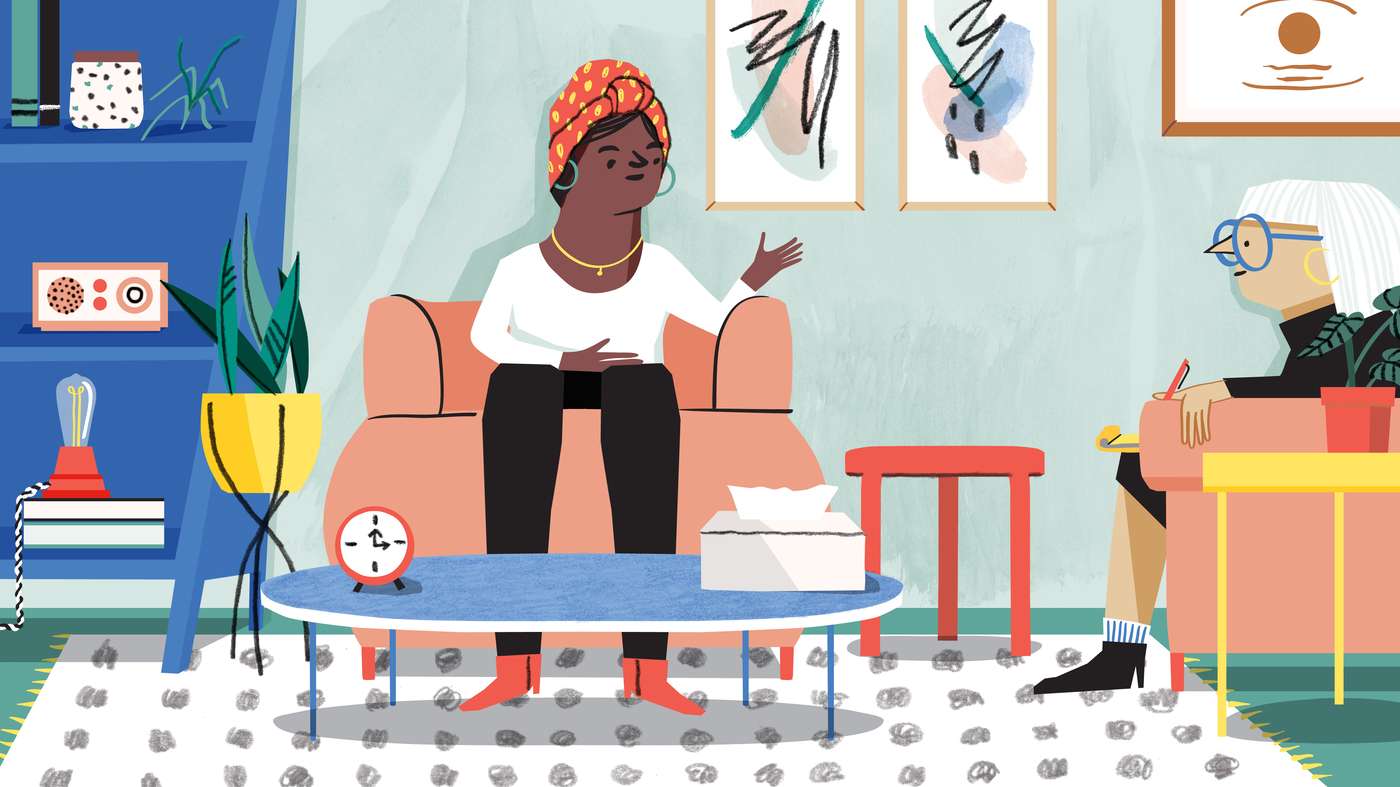How to start therapy
 Enlarge this image
Enlarge this image
Lindsey Balbierz for NPR
Lindsey Balbierz for NPR
Feeling anxious? Overwhelmed? Unhappy? Not sure what you’re feeling at all? These might be signs that your “check engine” light is on and seeing a therapist could help.
If the mere thought of trying to find help seems overwhelming, you’re not alone. Plenty of people put off seeking treatment or try to ignore symptoms because mental health is often easier to brush off as not urgent.
“We feel like there’s a hierarchy of pain, and if our problem doesn’t feel big enough, we wait until we’re basically having the equivalent of an emotional heart attack before somebody will make that call,” says Lori Gottlieb, a psychotherapist, advice columnist and author of the book Maybe You Should Talk to Someone.
Explore Life Kit
This story is adapted from an episode of Life Kit, NPR’s podcast with tools to help you get it together. Listen to the podcast at the top of the page, or find it here.
On top of that, the process of researching and scheduling that first appointment can be an emotional burden on its own — but procrastinating often allows the problem to grow. If you wait until things get really bad, the harder it will be to address.
We’ve got four tips to help you make therapy work for you. Be sure to listen to the Life Kit episode “How To Start Therapy” for more advice from experts who know that this is more than just making a phone call. If it were that easy, you’d have done it already!
1. Acknowledge stigmas that might be holding you back from seeking help.
The fear of being stigmatized can keep us from seeking treatment. Our attitudes about mental health likely come from family, friends, society at large, the media — and even our own inner voices.
“I think that a lot of people feel like if they start therapy, that means something’s wrong with them and other people might look at them differently,” says Gottlieb.
The reality is that people close to us often notice when we’re having a hard time. In fact, they’re likely catching some negative side effects, since we tend to take things out on our loved ones. Remember, you’re doing this for them too.
A good first step is to reframe therapy for yourself. “I think of seeing a therapist as just getting a second opinion about what you’re doing,” says Pahoua Yang, vice president of community mental health and wellness at the Amherst H. Wilder Foundation. “And then you can decide from there.”
If you’re concerned about privacy or disclosure, therapy is confidential. No one has to know! Licensed mental health professionals are bound by the law to protect your privacy. Unless someone is a threat to themselves or others, what goes on in therapy stays in therapy.
2. Find the right therapist — or type of therapy — for you.
Start by making a list of potential therapists. If you have medical coverage, your insurance company can help make that list for you. Ask the company for some nearby professionals who take your insurance.
Psychology Today also has a database, which you can use to search for providers in your area, along with specialties, reviews and experience.
Once you’ve identified a few potential therapists, reach out. Come up with some starter questions to ask when you interview them over the phone. What experience do they have working with your issue or community? How does a typical session with them work? Do their available hours match yours?
Asking questions before a session can help you know what to expect. But Gottlieb says the visit itself is the most important piece. “The reality is, you’re not gonna know if it’s the right fit until you’re sitting in a room with that person,” says Gottlieb.
If transportation, access or motivation is a problem, online therapy like the app BetterHelp might be helpful. (BetterHelp is a sponsor of NPR.) You can also ask to do video sessions, just make sure the therapist is licensed in your state. Otherwise, the therapist can’t legally treat you.
Not insured? Or on a tight budget? Look up a local clinic at a hospital or university where you can get low- to no-cost therapy with a therapist in training.
That’s actually how Gottlieb got her start as a therapist. “I trained at a clinic where people came in for no fee or a very low fee,” she says. “I was supervised by licensed clinicians. That’s also a great way to get help.”
Don’t feel ashamed or shorted by the idea of low-cost therapy. Gottlieb says clinic sessions actually have an advantage over pricier options.
“In fact, you probably have more supervision than a private-practice clinician does, because when you’re training, you have several sessions a week of supervision, so your case gets a lot of attention when you’re in a clinic.”
Group therapy can also be a great low-cost option. Group sessions tend to be relatively affordable compared with one-on-one sessions — sometimes even free.
Open Path Collective offers a network of therapists who charge $30 to $60 a session. And some professionals price their sessions on a sliding scale fee, meaning their rates vary based on a customer’s ability to pay. If you can’t afford your preferred professional’s rates, it’s worth asking if sliding scale payments are an option at the therapist’s practice.
3. It’s OK to move on to a different therapist, or kind of therapy, altogether.
If your current therapist doesn’t feel like a good fit, it’s fine to “break up” with the person.
“You want to make sure you find somebody who actually feels like they get you,” says Joy Harden Bradford, Ph.D., host of the podcast Therapy for Black Girls. “It’s OK to say, ‘Hey, I think I may need something else,’ and to try to find another therapist who’s going to be a better fit for you.”
But after all that work of getting into therapy, it might feel daunting to dump someone and start over.
Harden Bradford understands. She says it’s important to push through that uncomfortable conversation and find something that works for you. Plus, she says, the therapist likely isn’t going to be mad at you.
“It is a part of our training, and we know that kind of thing happens,” she says.
Mental health professionals want you to get better, even if it’s not in their care. Your current therapist might even be able to help identify a colleague who would fit better.
4. If you’re comfortable with it, talk about therapy with others.
If you’re already in therapy, and you feel comfortable, be open about it.
John Kim, also known as The Angry Therapist, says he found an online following when he opened up about his divorce and his own mental health treatment.
“I would share … all the revelations I’m having about myself,” says Kim. “And how much that’s helping my relationships at work, at home … and all of that happened because of me starting therapy.”
Kim says he wishes more people were open about going to therapy. He wants to see it normalized and encourages working it into conversation.
Just keep it subtle. No need to share details. Simply let others know that you’re prioritizing your mental health.
But Kim says it’s important to remember that if you’re sharing because you think someone else needs mental health support, it’s best to show, not tell.
“The best way to get someone in therapy is by example … doing therapy and living a different way where they notice. To tell someone to go to therapy, that’s not gonna land well.”
Breaking down a stigma takes time. By talking openly about therapy and demonstrating its benefits, you just may inspire someone else to try it out.
Editor’s note: In the original version of this story, we failed to mention that BetterHelp is an NPR sponsor. A full list of Life Kit sponsors is available here.
If you want more Life Kit, subscribe to our newsletter.
The audio portion of this story was produced by Audrey Nguyen.
Therapy is designed to help you feel better and live better. Here are some tips to help you get started.

Share on Pinterest
Oliver Helbig/Getty Images
Therapy, also known as psychotherapy, talk therapy, or counseling, aims to help you tackle troubling emotions, thoughts, behaviors or life situations.
On a routine basis, therapy involves visiting with a mental health professional one-on-one, whether online or in person. Starting psychotherapy is a personal decision, so you decide what environment or schedule works best for you.
Everyone’s reasons for seeking therapy are different. Some people attend therapy every week for years, while others just go for a few sessions. Most importantly, if you feel like you need someone to talk to right now, or if difficulties are greatly interfering with your life — this is probably a good time to start therapy!
Why should I consider therapy?
Therapy aims to investigate the root cause of your thoughts, emotions, and behaviors. Your therapist can help you shine a light on harmful patterns, and assist you with adjusting and coping.
People seek out therapy for a variety of reasons, including:
- managing long-term or severe stress
- discussing personal issues you don’t feel safe or comfortable talking about elsewhere
- processing a traumatic event
- major life events, such as the loss of a loved one, a new move, or relationship issues
- experiencing symptoms of depression or anxiety, or are concerned you may have a mental health condition
- having been diagnosed with a mental health condition, and needing help coping with your symptoms
Let’s look at some general tips for starting therapy.
1. Ask your primary care doctor
Primary care physicians and family doctors are a great resource for whole-body health issues. Your doctor can refer you to a mental health professional that fits your needs.
Mental health is just as important as physical health, so be open and honest about how you’re feeling, and don’t be afraid to ask questions.
Primary care physicians often refer people to a psychiatrist, which is a mental health professional who can prescribe medication. If you want a referral to a therapist or counselor, request this early on.
While your doctor might have a name in mind right away, you can also do your own research.
Finding your therapist
While many people like and stick with their first therapist, others need to try different options before settling in. Working to improve your mental health is a journey, so try not to be discouraged if things don’t work out perfectly at first.
Here’s some guidance for finding the right therapist:
- Find a Therapist and Mental Health Support
- How To Find the Right Therapist: 10 Tips
- How to Vet a Therapist
- How to Change Therapists: 5 Steps
You might consider looking for a therapist who understands your cultural background, or has expertise in working with people from your community.
No matter what you’re looking for in a mental health professional, there’s someone out there for you.
3. Honesty is important
You can consider your therapy sessions a no-judgment zone, so make sure you remain as open and honest as possible at all times!
If you are over 18, your therapist is bound by confidentiality. This means anything you discuss in your sessions is completely private — with exceptions including homicide, suicide, and abuse.
If you are under 18, therapists are trained to bring information to parents only in rare circumstances, and the therapist will inform the client before they do so.
Having clear communication and a secure level of trust allows therapy to work effectively and efficiently. The more information your therapist has, the more they can help. Try to explain your symptoms in detail, including severity and frequency.
4. Don’t be afraid to ask questions
A strong relationship with a mental health professional depends on communication from both parties.
Feel free to ask questions, whether about the process of therapy or your symptoms. Your therapist is there to not only listen, but also to give you constructive feedback and guidance.
This includes openly discussing your goals with your therapist. Ask yourself, “What do I want to get out of therapy?”
Your therapist will also have some questions for you. Their queries may include basic demographic information and your reasons for seeking therapy.
What should I ask my therapist?
When you connect with your therapist, you will want to ask some of the following questions:
- What type of clients do you normally work with? (This can help you find out if they specialize in working with a particular gender or age range.)
- Are you licensed?
- What are your areas of specialty or expertise? (You can decide whether their areas of expertise fit with what you are experiencing.)
- What treatment methods or approaches do you use?
- Do you accept my insurance? (Make sure you know your therapist’s hourly rate, what your copay will be, and what the late fee policy is.)
5. Not every therapist will be your perfect fit
If you don’t feel an ideal connection with the first therapist you try — don’t stress! This is completely normal, and you may have to meet a few different therapists until you find the one right for you.
First impressions can be misleading, so even if you don’t click right away, it can be helpful to give that therapist a try for a few sessions, and then switch if needed.
The American Psychological Association estimates there are 85,000 licensed psychologists in the United States, so you have plenty of options to choose from.
When you initiate contact, it’s best to speak to a potential therapist on the phone or via video call to get a feel for their personality and style. This can help you feel more confident going into that first appointment.
6. Practice patience
Try to remember therapy is a process, not an overnight fix.
If you walk out of your first appointment feeling the same, or even worse, don’t be alarmed. It usually takes several sessions to develop a rapport with your therapist, and working through your thoughts and feelings takes time.
Sometimes, therapy may make you temporarily feel worse before you feel better, as you bring up difficult or traumatic emotions and experiences. Remember it’s okay to set boundaries around topics you aren’t ready to dive into yet. And it’s okay to cry.
Trust the process and focus on the work at hand. You got this!
What’s next?
Hope is at the heart of therapy.
You can continue your wellness journey by finding a therapist you’re interested in meeting with, and scheduling your first appointment.
Feel confident that you can feel better and live happier, and that by reaching out for support, you’ve taken a crucial step forward.
If you’re still not sure whether therapy is the best option for you, consider taking our free therapy quiz.




